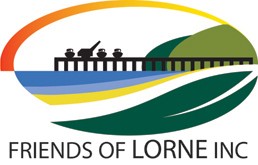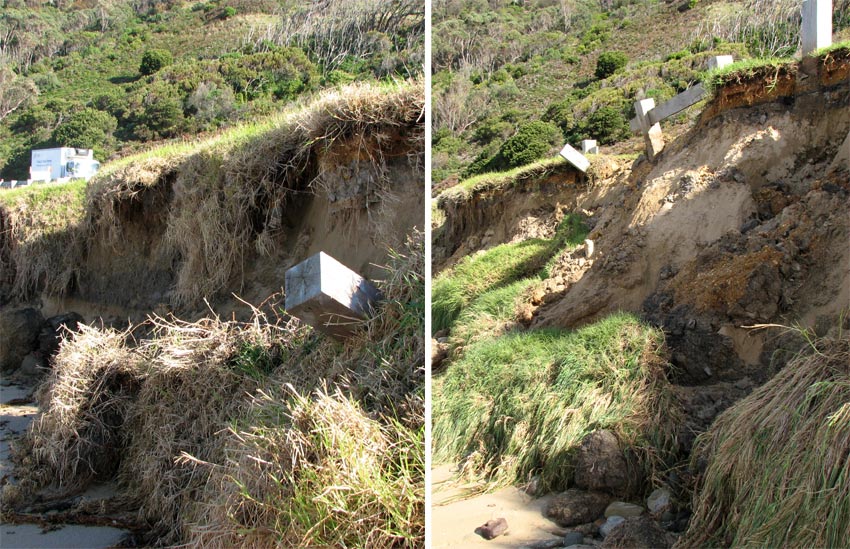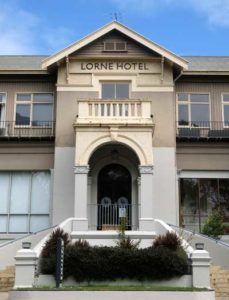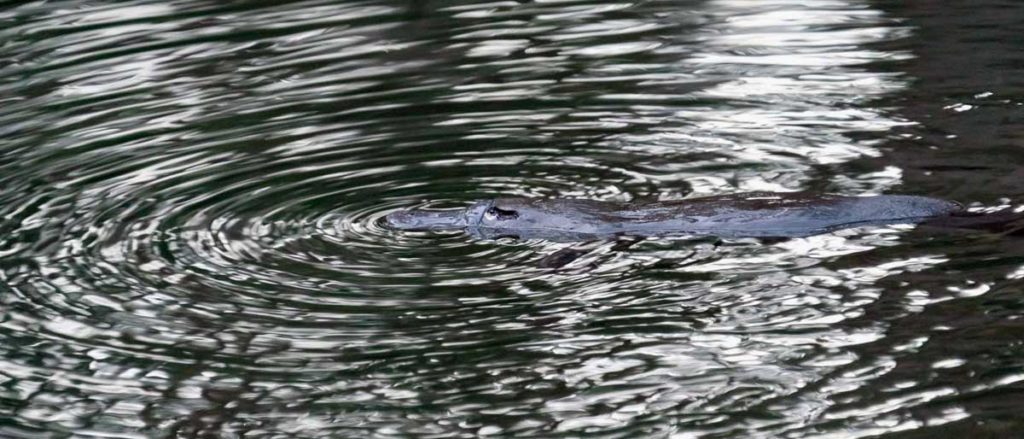Another year, another metre
Posts collapsed onto the beach at the Lorne end of Eastern View in 2020 (left). One year later (right) the coastline has moved back another metre and demolished the new fence
Coastal erosion has always been with us, but is nonetheless confronting. Why does it happen? What can we do about it? What should we do about it? Could a time come when the Great Ocean Road is permanently closed?
The Great Ocean Road Community Network (GORCN), of which Friends of Lorne is a member, has organised a webinar series on Coastal Erosion. This series, which will be moderated by well-known journalists Zoe Daniels, Robyn Williams and Gael Jennings, will examine:
- what is happening now,
- why it is happening, and
- the social, legal and economic consequences.
In the last of four sessions local authorities will have an opportunity to respond.
For more information and to register click here.
_____________________________
Lorne loses a long-time campaigner and advocate
Tribute from the Friends of Lorne. Reproduced with permission from The Lorne Independent, August 2021
With great sadness, Lorne pays tribute to Lawrie Baker AM who died at home, suddenly, on Thursday 15th July. Lawrie was a longstanding resident and property owner in Lorne. His life was one of deep and enduring community service.
Lawrie was the inaugural chair of the Western Coastal Board, which advised the Victorian and Coastal Council. He also served as Chair of the Foreshore Committee, as the first Chair of the Great Ocean Road Coast Committee (GORCC), and as president of the Lorne Planning and Preservation League (now known as Friends of Lorne). Lawrie had a major role in the establishment of the walking tracks through Queens Park, in particular the Rail Trail and the tracks leading down to the St George River from Teddy’s Lookout. Lawrie was active in book club, garden club, and well into his 80s, he was regularly seen on hands and knees pulling out weeds at Lorne Care and Friends of Queens Park working-bees.
Lawrie was a tireless crusader for all that is best about Lorne and its environment. On occasions, he was a force to be reckoned with. Even those finding themselves on the opposite side of the argument respected Lawrie’s commitment and determination. Lawrie stood up for what he believed. He resigned his Chair position of GORRC in 2006, citing the lack of financial support provided by the State Government for the sustainable management of the coast.
Perhaps, more than anything, the Lorne pier and the old fishing co-op building were Lawrie’s passion. In 2009, GORCC dismantled and removed the old crane on the pier not long after announcing they would not. Their unexpected action prompted a swift and daring response. The crane was rescued and stored away in a secret location by Lawrie and a small group, dedicated to seeing the crane return in some way, back near the pier, as a sculptural representation of our fishing heritage. More recently, Lawrie gathered 1527 signatures from Lorne residents and visitors against the demolition of the co-op building as part of the new proposed Pt Grey redevelopment. He inspired wider support of the cause of retaining the co-op building, launching a VCAT appeal.
Lawrie’s Queens Birthday honours were awarded in 2009 for his advocacy and leadership in developing Deakin University’s School of Engineering and for his extensive travel and work in developing the international student enrolment at Deakin. He was awarded the title Emeritus Professor upon his retirement.
Lawrie Baker will be much missed. Our thoughts and sympathy are extended to his wife Carol and their large family, to whom he was deeply devoted.
_____________________________
Membership matters
Friends of Lorne depends on the support of people who value both the natural and built environment of the Lorne region. We understand that many people are not able to keep an eye on all issues that arise in the region. We can’t either. But we do our best and appreciate the support of people who become members or contribute some of their time and expertise.
We welcome as new members David Worth and Eva and Bill Youl
Annual General meeting 2020-2021. Saturday 9th October 2021 4-5 PM
This year’s AGM will be a virtual one run on Zoom. In addition to the business of the meeting, Gary Allen, Lorne’s representative on the Surf Coast Shire Council, will be present for a session of general Q&A.
We hope members will be able to attend and will contribute their ideas for activities in the coming months. Non members are welcome.
Nominations for President, Secretary, Treasurer and Committee close this Friday October 1.
You can self nominate.
More details and documents for the meeting are here
A Zoom invitation will be sent to all financial members. You do not need to register in advance. Non-members who wish to attend should email us at committee@friendsoflorne.org.au
_____________________________
Friends of Lorne’s whales webinar
In early June 2021, in anticipation of the start of the whale season, we ran a ‘whale webinar’. Just a couple of weeks later a whale arrived in Loutitt Bay.
Mandy Watson of DELWP Warrnambool gave an excellent run down on whales and their habits, with a focus on the southern right whale. These are the ones most often seen along our coast, and that appear with their young off Logans Beach near Warrnambool. Or they do in most years. In 2020 no females calved in the area.
Mandy said that the absence of calves could be explained by the breeding cycle of southern right whales. It did not necessarily indicate that the whales were in trouble. At the time of the webinar, watchers were anxiously awaiting the 2021 season.
What happened? Whales arrived off the coast of south-west Victoria. And calved. Three of these calving females were known to be repeat visitors. A final report for the season is still a few months away.
If you were not one of the attendees at the webinar you can still catch it here.
_____________________________
Responses to issues
We do not have the capacity to respond to all of the matters that arise from all levels of government. Responding is further complicated by the fact that a proposed ‘strategy’, by definition, does not contain fine detail, but without the detail it is hard to interpret the strategy. Conversely, if the ‘plan’ is the fine detail, it is sometime difficult to see where it fits in the overall scheme of things.
Some of our recent activities are below. And you may notice that we could really use the services of a proof reader!
Point Grey update
At the Council meeting of 28 September 2021, the Surf Coast Shire Council (SCSC) decided to defer a decision on whether to transfer a piece of land at Pt Grey to the Great Ocean Road Coast and Parks Authority (GORCAPA) until October.
The VCAT hearing process exposed an issue in the development application. As it turned out, GORCAPA did not have consent for the development from the land manager (the SCSC) for a large parcel of Pt Grey Crown land which was designated as Road Reserve. It was subsequently agreed between SCSC and GORCAPA that GORCAPA should obtain consent from Council. VCAT agreed and the case has been adjourned until 8 October.
GORCAPA has made make strides in seeking to work collaboratively with the community in a co-design process that would start with looking to see how the co-op building could be saved and repurposed. But GORCAPA had only met with the community to begin to discuss the co-design process on 27 September. Hence, the terms of reference for the community co-design process and other matters were still to be ratified. This created reluctance in transferring the land management responsibilities. You will find a detailed history of the development proposal on our website here.
We thank many of you who used this pause in the proceedings as a chance to reiterate community concerns. Many of you wrote to SCS Councillors in July and again in September, asking them to prevent the demolition of the co-op building. The new Board chair at GORCAPA, Libby Mears, and the new CEO, Jodie Sizer, have acknowledged that the community have not felt heard or respected in the community’s prior dealings with GORCC. They are committed to a “co-design” process with the community, whatever the VCAT decision. This is much appreciated by the community and we thank Lorne ward Councillor, Gary Allen for his stewardship.
The co-op building is currently neglected and, to some, a bit of an eye sore. No one is asking to keep it that way. We are asking for design options with GORCAPA that would retain and enhance this historical and social landmark. We want Lorne’s fishing industry heritage clearly recognisable in its built form.
_____________________________
Economic development strategy – Surf Coast Shire Council
Results of consultation with users of the Surf Coast region were reported in some detail in the draft document. Community opinion supported aspects of conservation of the natural environment as the highest priority.
In the Friends of Lorne response we concluded that the strategy did not engage in a substantial way with conservation of our natural resources, including issues associated with mitigation and adaptation to climate change. We were disappointed that the evidence base for some assumptions appeared weak.
Friends of Lorne’s full response is here on our website.
Perhaps the most difficult problem for the future of the Surf Coast is climate change. It threatens the things we value most. This leaves us in a quandry because tourism, our main industry, is such an extravagant producer of greenhouse gases that it is sometimes called an ’emission factory’. How can we make a living from tourism and be tourists and reduce emissions? Those interested can read what Aireys Inlet resident Suzanne Cavanagh has to suggest here
_____________________________
Independent Review of the Wildlife Act 1975
Wildlife, as currently defined, includes some types of animals and not others. The lines drawn in 1975 are now contentious, indeed they probably were contentious in 1975 too. For example, deer, as game species, are partially protected.
There is a plethora of Acts and strategies that apply to the protection of biodiversity, sometimes further complicated by differing State and Commonwealth responsibilities. The task of the Independent Reviewers was to sort through the Victorian part of the maze.
In our response we set out some of the broad principles we thought should apply to the protection of biodiversity.
Our point of view may have been differed from most submissions because we also dealt with the tricky matter of what should happen when individual elements of ‘biodiversity’ become over-abundant. In Lorne this arguably applies to white cockatoos.
_____________________________
Lorne Hotel changes ownership
At Friends of Lorne, we care about the environment. We also care that Lorne has community services and activities for permanent residents, holidaying residents, campers and tourists. So, it is of interest when an asset like the Lorne Hotel is sold.
The Lorne Hotel was recently sold to the Merivale hospitality group for $38M. This is said to be Merivale’s first hotel acquisition in Victoria, but Merivale has extensive interests in New South Wales. Further information about this sale can be found here.
The outgoing owners of the Lorne Hotel, Paul Upham and his family, have been associated with the hotel since the late 1980s. Paul also is known for the energy he has put into activating the Lorne Business and Tourism Association (LBTA) over the years. The LBTA is host of the “Love Lorne” campaign and organiser of the Festival of Performing Arts. Paul intends to stay on assisting the LBTA for another year. Right now, as a major project, the LBTA is working hard to secure better accommodation for Lorne’s casual workers.
Having bought a home in Lorne, Paul says, “I’m now looking forward to having a drink from the other side of the bar.”
The life of the hotel in many ways has reflected the life of the town itself, over the years. The Lorne Hotel has served us hospitality since 1876. It was Lorne’s first hotel, followed by the Grand Pacific, which was built in 1879.
The Lorne Hotel would have been a welcome sight to many when it was first built in 1876. The Mountjoy’s guesthouse (Erskine House) was originally called The Temperance Hotel and served no alcohol. The Lorne Hotel was built by Joseph Duncan and Theodore Hancock. The first licensee was John Rooke.
In August 1910 a court case hit the headlines from Kalgoorlie to Sydney. The Rookes brought a case against T.J. Anderson for damages caused by the trespass of his cow at the Lorne Hotel. The cow “had a reputation throughout Lorne for its inquisitiveness and destructive habits”. The cow climbed the stairs, entered bedrooms, ate mattresses, broke furniture, went out on the balcony and ate a bag of potatoes and a case of apples. The Rookes were awarded damages.
The hotel was put under quarantine in February 1919 during the influenza epidemic, when seven guests were confirmed as cases. According to The Geelong Advertiser, the health officer for the District, Dr Kirkpatrick noted that “some objection was raised” to his orders. So, he called in two constables from the Geelong police to “enforce the law and make sure no one unauthorised enters or leaves. At the same time some 27 cases were in the Geelong Hospital under the care of Dr Day. He published in the Geelong Advertiser, a description of the case severity of inoculated versus non inoculated cases “from which the public can draw its own conclusions as to the merits of the vaccine.” Like today in other words, vaccinated patients had milder illness.
The hotel was nearly destroyed by fire later in the same year and oral history accounts tell of beer barrels being rolled down the path from the upstairs bar, and some being “souvenired and secreted away” into houses.
Hector and Mabel Stribling were at the helm by 1938. Hector had also been the first licensee of The Grand Pacific Hotel. At one point in time the Stribling family owned both hotels (and later, Erskine House). Hector was a prominent Lorne citizen, secretary of the Lorne Progress Association, Winchelsea Shire Councillor and active in building Lorne’s amenities and civic infrastructure through his service on the RSL, the Foreshore Committee and Recreational Reserve Committee.
But the story of the Lorne Hotel is really about its hospitality. Lorne has always been a tourist destination. Until well into the 1900s, the guest list at the Lorne Hotel was published in The Herald and the activities of guests featured in the Social Notes. It hosted grand dinners, such as for the Premier and the Board of the Great Ocean Road Trust. Famous regular visitors included Robert Menzies and his wife Pattie. They usually came to stay in late spring or early autumn. At about 10.30 each morning they would walk out to the pier and take up position on a bench to watch the comings and goings of the fishing fleets, before returning to the hotel for lunch.
The Upham family first leased the hotel from 1988 to 1995 in partnership with Garry and Loretta Parsons. Paul remembers the hotel back then as an “old-fashioned, drinking and rock ‘n roll pub. Food was a second thought, with a beer garden, bottom bar and nightclub awash with young people enjoying themselves.”
The Upham family purchased back the lease and the freehold in 2010 . By this time, the demographics of the visitors to Lorne had changed, with more families and day trippers, as Geelong and the western suburbs of Melbourne expanded.
During their time as owners, the Uphams oversaw a number of changes.
“I think my proudest achievement is changing the dynamics of the venue from a pub to a multifaceted facility with great accommodation, function spaces and restaurants.” Paul says.
The Uphams built a function room upstairs, now the Coda Restaurant. They renovated all the accommodation, under the guidance of local interior designer Georgina Jeffries They removed the bottom bar, replacing it with the Movida restaurant. They installed a kids’ playroom.
It will be interesting to see how the changing demographics and visitation patterns (post-COVID) might again influence the configuration of the hotel’s amenities under the new owners. What might be the flow-on effects for the town?
The hotels have always had a strong impact on the Lorne economy. For example, as late as 1934, Lorne fishermen were still catching fish using nets off the main beach. But then Hector Stribling purchased a boat for Cyril and Arthur Norton to catch fish for guests at both the Pacific Hotel and the Lorne Hotel. More boats followed. A local industry was born.
SOURCES
1. Stirling D. Lorne. A Living History. Lorne Historical Society. Lorne. Victoria 2004
2. Inquisitive cow walks up hotel stairs. Kalgoorlie Miner 11 August 1910
3. Twenty Seven Now in Geelong Hospital. Lorne Hotel Quarantined. Geelong Advertiser 10 February 1919
4. Hunt I C. Feel the Sea Wind. 3rd Edition 1999 Desktop Dynamics 58 Moorabool St, Geelong
5. McComb S. A Short History of Fishing in Lorne. Lorne Historical Society. Lorne. Victoria. 2021
Interested in Lorne’s history? Here is a link to a distressing incident faced by the Rookes early in Lorne Hotel’s history. Reproduced with permission from the Lorne Independent and with thanks to the work of the Lorne Historical Society.
_____________________________
Arts
Lorne Sculpture Biennale deferred
The biennale will no longer be held as planned in November 2021. It has been rescheduled to 12 March to 3 April 2022.
Popupart
are the organisers of a zoom based, free program for creatives called ArtsActions. They have asked us to draw your attention to their program. That program is endorsed by the Surf Coast Shire Council
_____________________________
Natural history note
From the Australian Platypus Conservancy & Mary Lush
Lorne platypus generating concentric ripples as it grinds its food
As mentioned in the last newsletter, Lorne now boasts a platypus monitoring group working under the umbrella of the Australian Platypus Conservancy. Our group and the APC could use your help.
The Otways region has long been considered a platypus stronghold, though there are some signs that numbers may be declining there. For instance, platypus were often sighted in the Erskine River right in the heart of Lorne until the early 2000s, but there have been no verified reports in recent years.
To help map where platypus still occur in the eastern Otways, Dr Melody Serena of the APC is asking that persons who happen to see a platypus in the next few months in any waterway between Lorne and Apollo Bay consider sharing the location and date with the Conservancy. Along with providing a better idea about the platypus’s status, it’s hoped that this information will assist the local monitoring group to track how well numbers are doing.
“If you see a platypus, the best thing to do is to report the details to the Australian Platypus Conservancy website www.platypus.asn.au. We’ll make sure that the details are accurately recorded and only used for genuine conservation purposes, including better monitoring” Melody said.
Now is a good time to look – platypus are just coming off their peak breeding season. Sightings will probably then decline for a while before rising again in December.
The platypus is one of the strangest creatures on Earth. This unique mammal reproduces by laying eggs, is venomous (in the case of males) and possesses many other unusual features including a “sixth-sense” electro-reception system in its amazing bill. In early 2021 the species was listed as ‘Vulnerable’ in Victoria and there is a need to establish how populations are faring across the state so appropriate local conservation action can be planned.
Melody notes that “There is a bit of a myth that platypus only come out at night and are very shy and sensitive and therefore difficult to observe. In fact, platypus often are seen feeding during the day, especially in the early morning and late afternoon. The trick to platypus-spotting is to be quiet and watch particularly for the distinctive ‘bulls-eye’ ripple patterns created when an animal dives and when it chews its food while resting on the water surface.”





